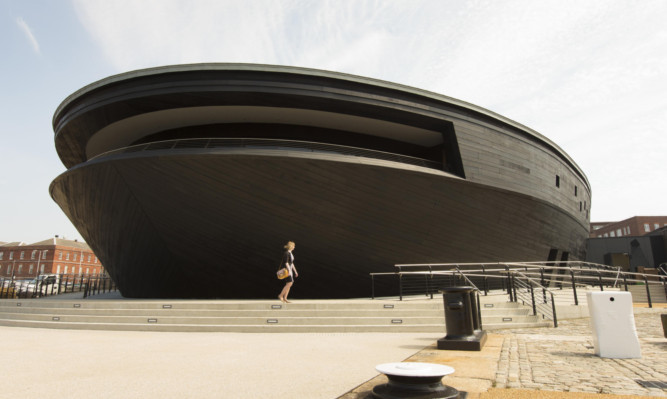Secrets of the Henry VIII’s warship Mary Rose will finally be given up today when the £27 million museum housing the wreck opens to the public.
The magnificent Tudor vessel, undiscovered for centuries until it was found by divers in 1971, will go on show at its new home in Portsmouth today, reuniting the warship hull with thousands of its artefacts for the first time since they were lifted from the seabed in 1982.
Proceedings at a media day on Thursday began with a wreath-laying ceremony at the wreck site in the Solent followed by a gun salute and water cannon display as the Mary Rose bell became the last item to be brought to the new museum.
A flaming arrow volley was then fired at Southsea Castle, the place where Henry watched the Mary Rose sink, before the unveiling of the museum accompanied by a fanfare from the Royal Marines Band.
Ahead of the standard being dropped, the ship’s bell, which was earlier rung at the wreck site, was symbolically carried into the museum by an escort of Royal Navy sailors.
https://youtube.com/watch?v=McGWY4WFbs8%3Frel%3D0
The “jewellery box” centre, designed by Wilkinson Eyre architects, has been described as creating a snapshot of Tudor life every bit as vivid as Pompeii sums up Roman times.
The gunship sank off Portsmouth, Hampshire, in full view of Henry VIII during battle with the French on July 19 1545.
After extensive excavations, supported by Prince Charles who dived on the wreck site, more than 60 million people watched as the hull section was lifted to the surface on October 11 1982 – more than a decade after it was discovered by divers.
The wreck was placed in a museum where it has been sprayed with water and then a preservative until just last month.
But its artefacts were housed separately and now the Mary Rose Trust believes it has the home it deserves to show off the wealth of treasures.
The museum has been praised by historians and prominent supporters including Dr David Starkey.
He said: “The Mary Rose is the English Pompeii, preserved by water, not fire. All Tudor life is there, it is like stepping inside a Holbein painting.”
The total cost of the project to conserve and house the only 16th century warship on display in the world has cost £35 million, with the Heritage Lottery Fund (HLF) providing more than £32 million during the past 18 years.
The Mary Rose Museum at Portsmouth Historic Dockyard, the same place where the ship was built in 1510, opens to visitors today.
